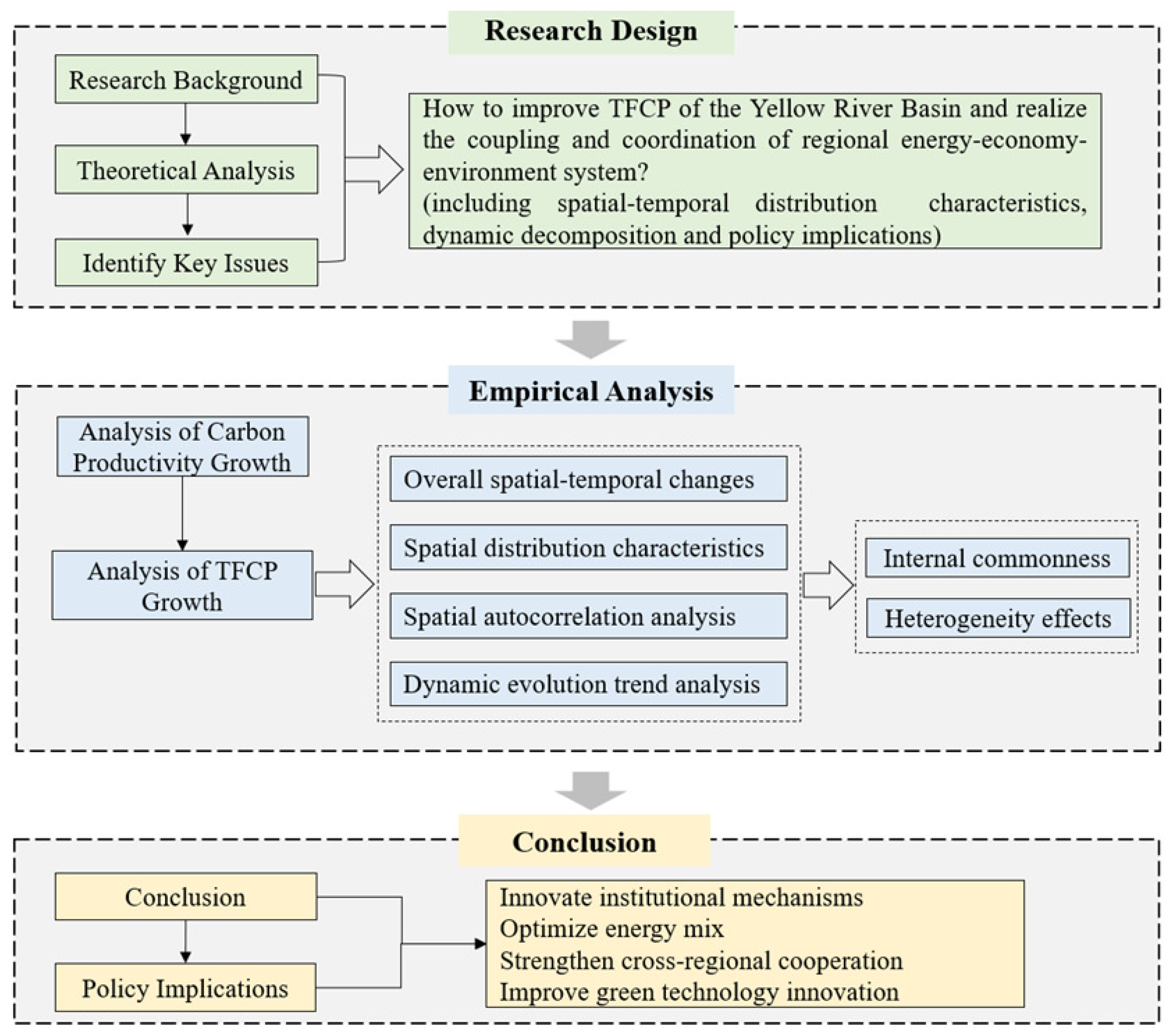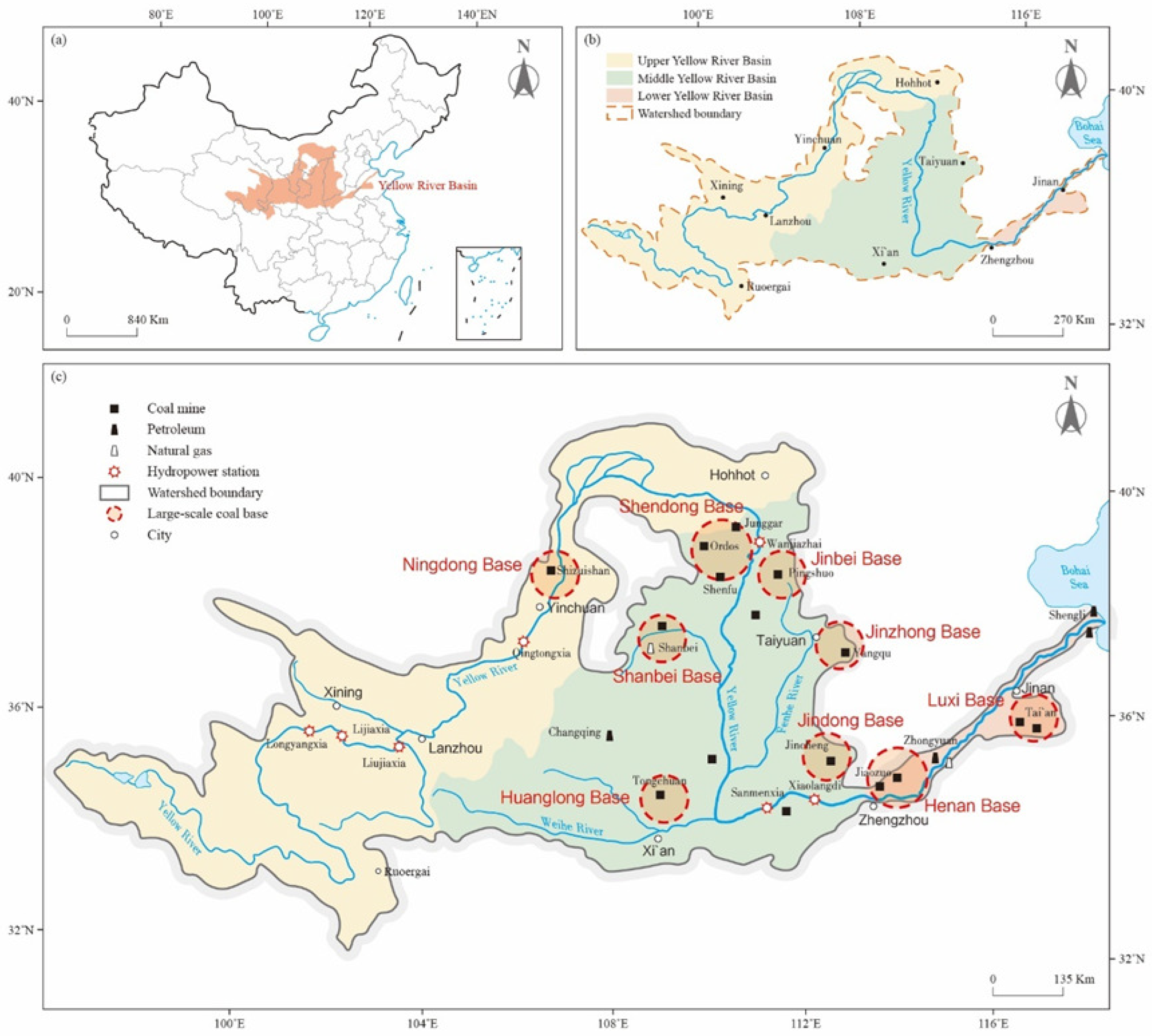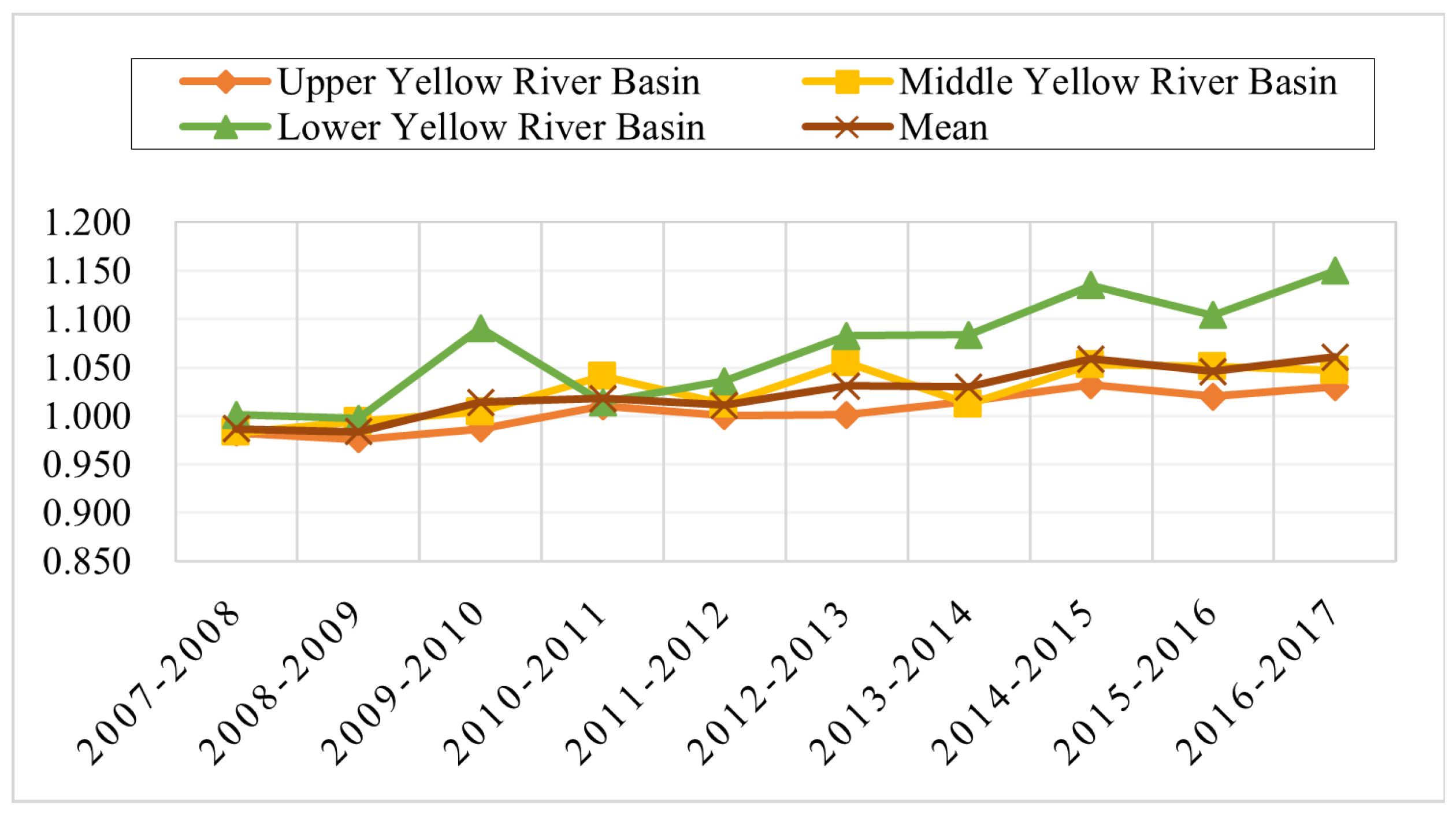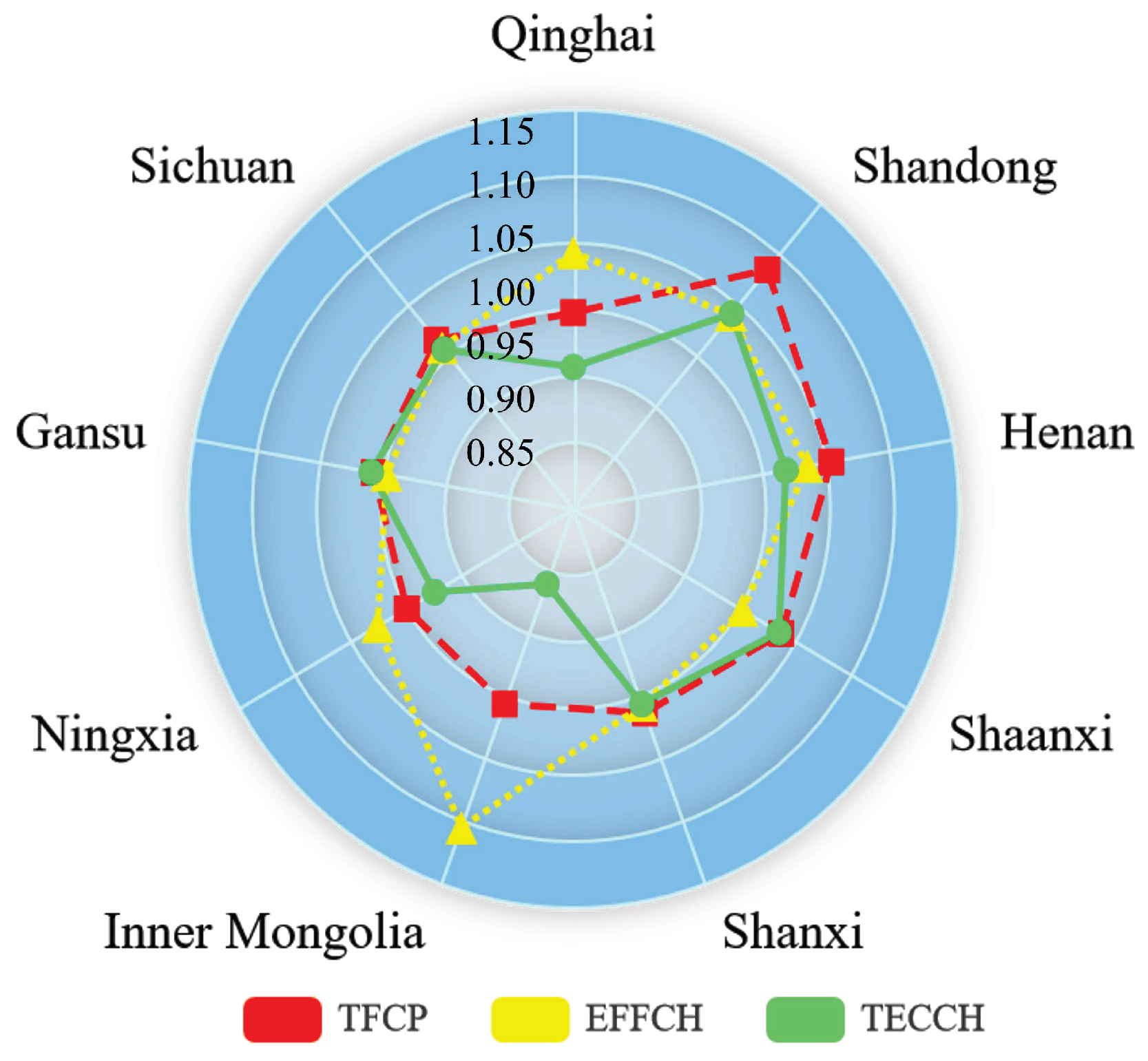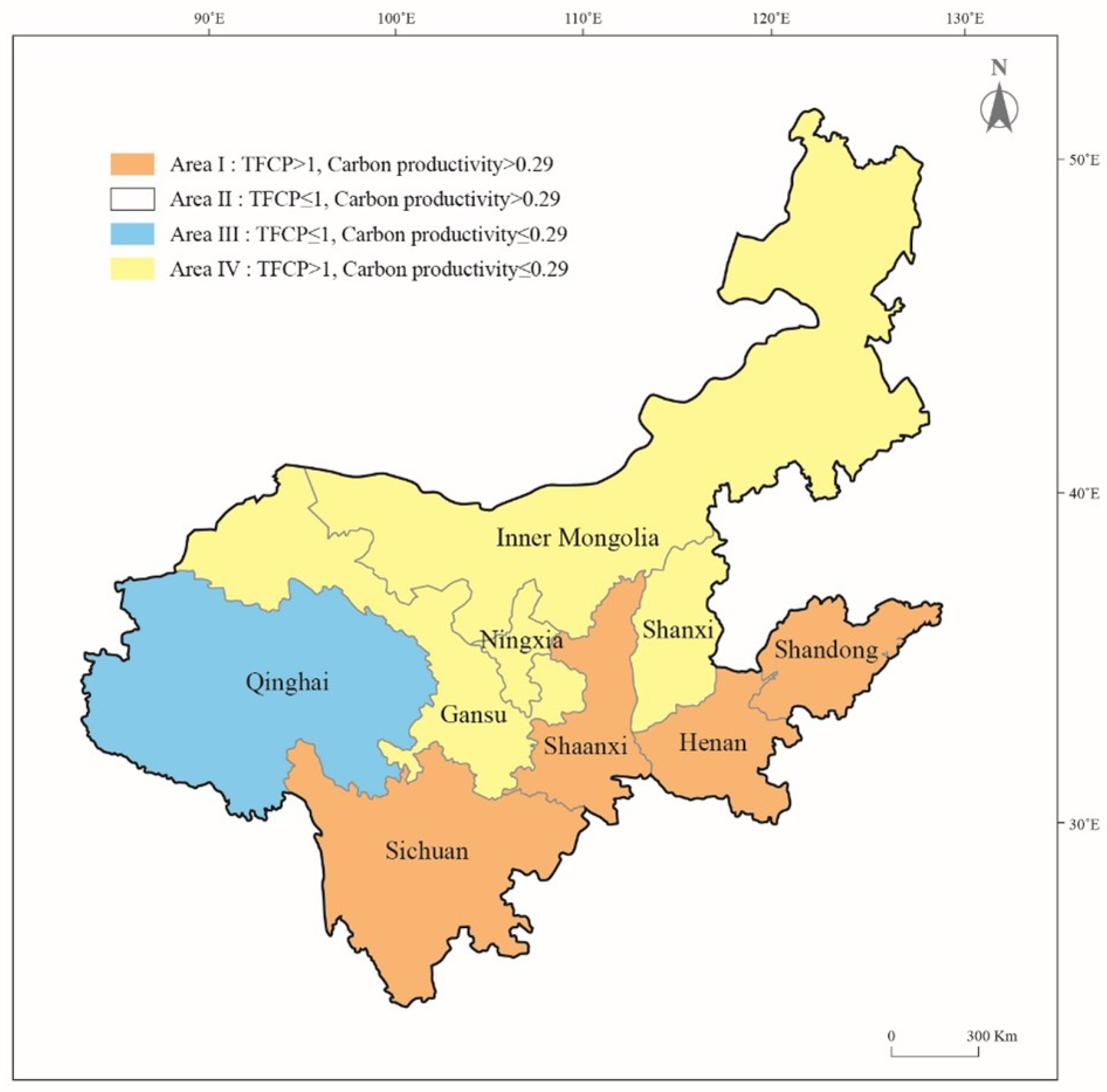Carbon productivity is an indicator proposed to measure carbon emission performance in different spatial and temporal scales. It has different economic interpretations under different measurement methods. Carbon productivity can fall into two mainstream categories by definition: single factor carbon productivity and total factor carbon productivity. As such, the paper is tightly related to the above two strands.
2.1. Single Factor Carbon Productivity
In recent years, carbon productivity has gained broad interest in academia. Relevant research is abundant, focusing on its definition, measurement methods, dynamics decomposition, and the relationship between carbon productivity and economic growth. These studies have enriched the research content of carbon emission performance from different perspectives and spatial scales.
Conceptually, the origin of carbon productivity can be traced back to the 1990s. Scholars Kaya and Yokobofi first put forward the connotation of carbon productivity, defined as the ratio of GDP output to per unit of carbon dioxide emission [
12]. In 2008, McKinsey again expounded the connotation of carbon productivity in its report (Report, M., 2008. The carbon productivity challenge: curbing climate change and sustaining economic growth. Mckinsey Global Institute.) “Carbon productivity challenge: curbing global change and sustaining economic growth”. So far, carbon productivity has attracted extensive attention from academia and society. Later, carbon intensity (Carbon intensity has been an important indicator for policy-making reference in the Chinese government. See [
13] for more details.) is proposed and regarded as an alternative or proxy to carbon productivity. Carbon productivity and carbon intensity are generally considered to be the most effective ways to solve environmental problems [
13,
14,
15]. The main purpose of explaining carbon productivity is to link it with the policy goals. Carbon productivity bears on balancing the relationship between decarbonization and sustainable development, and it is a critical “bridge” connecting economic growth and environmental protection [
16]. As revealed in [
5,
17], the core aim of carbon productivity is to create greater social value with less resource consumption and less environmental pollution. As an intuitive measurement of carbon emission performance, carbon productivity considers synthetically ecological and economic benefits, adding new constraints in the analysis framework of social economy through input factors [
18,
19,
20]. It is more appropriate for considering carbon productivity as an equivalent factor productivity like capital productivity and labor productivity, to reflect the scarcity and urgency of carbon emission space under the restrictive conditions faced by the social economy [
21]. Such studies are highly impactful for policy making.
The measurement of carbon productivity makes the effort of carbon emission control accountable and provides intuitive insights for academia and practice. According to previous findings, the mathematical expression of carbon productivity and carbon intensity are reciprocal to each other, which is employed to describe the internal mechanism of carbon emission governance [
22,
23]. Based on its basic connotation, most scholars calculate carbon productivity in different spatial scales such as countries, regions and industries. Among these studies, for example, presently scholars Jahanger [
17] and Yu et al. [
23] explored the dynamic evolution and regional differences of carbon productivity using the method of convergence and decoupling index. Moreover, taking China as the research object, Wang et al. [
16] investigated carbon productivity and predicted its change trend in 2005–2020. According to [
24], there were obvious regional and industry differences in carbon productivity through the comparison of Shanghai and Shaanxi, China. Above all, these studies convinced that focusing carbon regulation on carbon productivity was in line with the reality of environmental regulation and climate control. Notably, some studies argued that although the current level of China’s carbon productivity was lower than that of developed countries, its growth rate remained high [
25,
26,
27], these studies might be of assistance to accurately formulate environmental regulation policies in developing countries, and his has received considerable attention from policymakers.
In terms of the dynamics of carbon productivity, a majority of researchers confirmed that technological progress was the dominant force. This theory is supported by many empirical studies. Accordingly, related research [
28,
29,
30] suggested that technological innovation plays a key potential role in carbon productivity growth. Many studies, for example, Yu [
25] conducted the measurement and decomposition of carbon productivity, and the results showed that production technology exhibited an increasing trend for power plants. More importantly, some studies confirmed that environmental regulation also had positive impact on carbon productivity, such as [
10,
23], etc. Furthermore, the results concluded by Liu [
9], Song and Han [
31] indicated that there was a significant U-shaped relationship between environmental regulation and carbon productivity. It is especially true that regional heterogeneity of propulsive power on carbon productivity exists universally. Similarly, Wang et al. [
16] presented that the impact differences of heterogeneous environmental regulation on regional carbon productivity exactly existed. The rest of studies analyzed the impact of urbanization [
10], income inequality [
32,
33], factor input [
34], foreign direct investment [
30,
35] on carbon productivity. However, these studies are hard to form a unified conclusion.
2.2. Total Factor Carbon Productivity
Despite its ease of use and intuitive connotation, carbon productivity has its own limitation. Firstly, it only reflects partial aspects of carbon performance and neglects other input indicators, thereby falling to reflect how far is the production activity from the optimal production state, and to judge whether current production situation is effective, let alone used for long-term prediction [
36,
37]. Additionally, its measurement covers a wide range at the national level and produces a weak role in guiding inter-provincial differences and policy formulation [
16,
22]. Finally, in the absence of production efficiency of total factor, carbon productivity ignores the substitution effect between input factors and the influence of random factors. Therefore, it is of great necessity to measure carbon productivity in an integrated production framework.
Recently, a growing number of researchers began to study TFCP, and it has been broadly recognized by academia (See, for example, [
5,
38,
39,
40], etc.) In definition, the concept of TFCP has been discussed, more examples of such studies include [
38,
41,
42], etc. In conformity with prior findings, academia has not yet reached a consensus on the definition of TFCP. It is worth noting that the concept of TFCP is derived from total-factor productivity (TFP) and total-factor energy productivity (TFEP), which are widely utilized to measure economic development in environmental economics [
40,
43]. On this basis, some researchers insisted that CO
2 should be regarded as a production factor like labor and capital in the total-factor analysis framework. This theory is supported by many empirical studies since it is more consistent with the appeal of green and sustainable development. For instance, considering carbon emission as an output variable, Ramanathan [
44], Kuang and Peng [
45] and Shen et al. [
46] investigated environmental TFP in their studies. More representative literature includes [
42,
47], etc. On the above basis, more scholars argued that it was reasonable to view CO
as an unexpected output and integrate it into total factor analysis framework, e.g., [
48,
49].
Theoretically, the measurement of TFCP is more complicated compared with single factor carbon productivity. There are two mainstream research methods: Stochastic Frontier Approach (SFA) and Data Envelopment Analysis (DEA). DEA is a non-parametric technique and is more favored by scholars in that there is no need to determine any weight and specific function expression, and it could avoid model mis-specification risk. As such, DEA was widely utilized to evaluate total factor carbon emission performance in academia. Furthermore, the DEA linear programming method constructed by Fare, Grosskopf and Norris [
50] is preferred to measure Malmquist index (abbreviated as MCPI) by most researchers. For instance, Zhang [
51] employed DEA Malmquist model to compute China’s TFCP, its results highlighted that Malmquist index was an effective way to assess TFCP. The literature of [
5,
38,
40] also drew similar conclusions. Whereas, DEA ignores the statistical noises and other random errors. Different from the aforementioned literature, some recent studies developed SFA and advocated using it for efficiency evaluation, e.g., [
52,
53,
54]. As discussed in Tan [
55] and Li [
56], the merit of SFA was that it both took statistical noises and individual heterogeneities into consideration. However, Wang et al [
57] argued that SFA also had its own limitations, for instance, it was still needed to impose restrictions on the form of distance function.
To make up for the deficiency of production status and long-term application, some researchers advocated using directional distance function to trace productivity changes. The example of such studies includes [
38,
58], etc. As discussed in [
54], it needed to construct a corresponding technological frontier to investigate the production effectiveness in each phase, this will bring challenges to technological benchmark selection and technological inefficiency measurement. Thereupon, some studies developed a framework of biased technological progress and extended the relaxation directional distance function based on SBM model [
16,
35]. In this way, technological progress could be reflected in the catching-up process of each decision-making unit to the global cutting-edge technology. It further describes the low-carbon governance effectiveness under the existing technological progress, and perfectly presents the coordination between carbon regulation and economic growth [
59]. As verified by [
34,
60], energy and environment related innovations (hereafter carbon control technology innovations) may be a pivotal supplement to addressing the above problem. This has drawn much attention from academia and policymakers. Such studies provide a reliable theoretical basis for the research of carbon emission control.
Currently, exploring the sources of TFCP has not yet formed a systematic framework. These empirical studies are distinguished for the fact of that research methodology varies, e.g., multi-dimensional decomposition technology, nonparametric directional distance function, LMDI [
57,
61]. Since the subjects of these studies are different, the research perspectives are also of great imparities. Most stirring evidence confirmed that per capita GDP, technological progress, energy consumption structure, industrial structure adjustment, independent innovation and environmental regulation have great influence on TFCP [
8,
39,
48].
To sum up, previous studies have given in-depth analysis on carbon productivity and laid a solid foundation for us to study carbon emission performance, yet the study of TFCP in the Yellow River Basin has yet received the attention that it deserves. There is still some expansion room. On the one hand, existing studies have focused on the world’s major economies, countries along the Belt and Road, the national level, China’s eastern coastal areas, Beijing-Tianjin-Hebei Urban Agglomeration, the Yangtze River Basin, and specific sectors such as industry, manufacturing, agriculture, construction, etc. [
23,
24,
26,
34,
36]. However, far too little attention has been paid to the systematic research on the TFCP of the Yellow River Basin. On the other hand, the existing single factor research in prior studies is lack consideration of the synergistic effect of multiple factors in production process, thereby falling to explore its dynamic evolution law and revealing the dominant driving sources. Besides, domestic research on TFCP is still in the exploratory stage and empirical evidence is still rather scarce. This paper performs the exploratory research in the existing studies. It is therefore the purpose of this paper to fill some research gaps by empirical evidence on TFCP in the Yellow River Basin.
